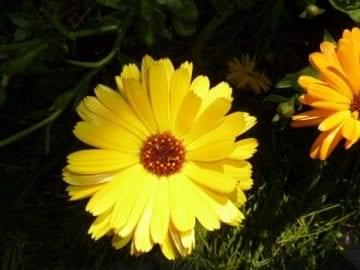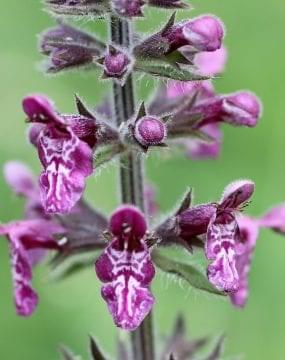Peony, known as bai shao or chi shao in TCM, is among the more common and famous of Chinese herbs, especially for women in their child-bearing years. Paeonia lactiflora is the one you’ll commonly find in gardens and nurseries. Paeonia officialis or P. Corallina are the ones classically used in Europe and the UK, where they grow wild. Paenia lactiflora comes in white (bai shao) or red (chi shao) that have long been used in Chinese medicine to ease menstrual cramping and regulate menses. According to Maude Greive, P. officinalis and P. corallina come in a male and female version, as distinguished by its roots, with a variety of different colored flowers.
Peony in Traditional Chinese Medicine
In Chinese Herbalism, Peony root is the most often-used part. It’s generally used in formulas designed to nourish and invigorate the blood. That’s pretty helpful if you suffer from migraines, cramping, muscle weakness or other symptoms that indicate cold, unmoving blood or blood stagnation. It’s also helpful in cases where blood or chi need a little boost to flow properly. I’ve paired White Peony root with Codenopsis to help invigorate the system. The two complement one another and, when combined with other herbs can give the whole formula a gentle energy boost. They are a natural pair to partner with other classic women’s herbs, like Angelica and Licorice roots.
Traditional Chinese Medicine makes a distinction between white and red Peony root. White Peony root, bai shao, is considered less hot and moving than Red Peony root, chi shao. Red Peony is used more for draining or reducing pain and cooling while White Peony is used more for tonifying and strengthening. Both share similar qualities, though, and are classified as bitter, sour, and cooling with an affinity for the Liver and Spleen channels.
Peony in Traditional Western Herbalism
In Traditional Western Herbalism, Peony root was traditionally used for spasmodic nervous conditions and those associated with estrogen-excess. Conditions like Epilepsy and lunacy were among those for which Peony was taken, generally in a tea form. Peonies were also considered a highly magical plant, offering protection from evil spirits and particularly those evils that traveled at night.
According to Matthew Wood, White Peony has been particularly useful for helping control or eliminate seizures in children, adults, and even dogs. The surprising element to this particular application is that all that’s required is to wear a necklace of fresh peony root around the neck, thus holding the peony root near the neck and head. This particular application of peony root has been successful in his experience, possibly even more reliable than an infusion of Peony root taken internally. He suggests that fresh root is key, so replacing it with more fresh root as the root dries is necessary.
As a women’s herb, White Peony is connected with estrogen-excess conditions. These are common in middle-aged to menopausal women, resulting in hot-flashes or night sweats, weight gain, flooding, cramping before and during menstruation, flushing or rosacea in the cheeks and upper body. Accompanying symptoms may include liver-excess migraines, insomnia, digestive upsets including vacillation between diarrhea and constipation, heart palpitations and chest-centered anxiety, irritability and acne especially on the chin. The later two are especially important signs in younger women struggling with excess estrogen patterns.
The Edible Peony
While TCM focuses mainly on using Peony root as a medicine, the flower is a delightful edible, too. Peony flowers are lovely infused in teas, added to cocktails, sprinkled on salads, and cooked into jams. They’re sweet with a wonderful floral aroma and flavor much like the scent of the fresh blossom. Medicinally, they’re far more subtle than Peony roots, but that doesn’t mean they’re entirely without merit. As a daily treat, Peony blended with other cooling summer flowers can help the body aim in the direction of releasing excess summer heat. That’s lovely, considering that Peony begins blooming just as the heat of summer starts to really kick in.
Peony in the Garden
Peony can be started from seeds or root divisions. It’s a lovely plant to add to the garden, although if you live in an area where ants are a problem you may want to plant it a bit away from the house. Peonies are particular partners to the Ant nation. Ants, particularly the little sugar ants or their tiny ant cousins, are attracted to the sweet scent and nectar of Peonies. They won’t do your blooms any harm, but in my yard it makes sense to not draw those tiny critters any closer to my home than necessary.
Peonies are pretty darn hardy plants, too. I’ve grown them in frosty climates, where the winter temperatures plunge well below zero degrees F or -17 degrees C and the ground freezes solid for months on end. I’ve also seen them blooming quite happily in warmer climates, where the worst chill of winter is a light frost. Given the right conditions, Peonies will take care of themselves quite happily.
The key is to offer Peonies plenty of sunshine through the growing season and well-drained soil all year-round. They can handle some shade, but it’s the sunshine that inspires them to really bloom. If you’re looking for a border of beautiful, sweetly-scented blooms you don’t need to work that hard tending, peonies may be just the ticket. They can tolerate mild drought, although will be happier with regular watering. They can handle a wide range of soils, from sandy to rocky to clay, so long as the drainage is good. They’d rather not stand in water very long.
Harvesting Peony
You can harvest Peony flowers at any point after they’ve begun to bloom. Peony can take a couple of years before the first blossoms appear, but once they’re going they generally keep on flowering through the summer and into early fall. They’re best used straight away, but can be dried and used relatively soon. They won’t hold their scent super long once dried and are best dried with the lowest heat possible.
Peony roots are best harvested after the third to the fifth growing season. Right about the time they’re ready to be divided, they’ll be ready for harvest. Once you’ve harvested them, wash them well and slice them into the sized pieces you’d like to use. I prefer roughly quarter-inch or 1 cm slices because they’re easy to measure later and will dry fairly quickly.
Using Peony Root
I like to include Peony root in teas with blood-building and tonifying herbs. I often include others, like Angelica Root, Rehmania Root, Licorice Root, and Codenopsis for building blood and tonifying the system. I generally aim for a dose of about 3-9 grams a day of White Peony root in the formula. So, if I’m creating a formula with two herbs for one day’s use, I would use up to 9 g of White Peony root plus the daily dose of the other herb, such as 2 g of Licorice Root, for a total in this case of 11 g. If you’re using whole root, as opposed to powdered or tea concentrate powder, plan on decocting rather than using a standard herbal infusion. White Peony root is somewhat hard, so it doesn’t infuse well but it decocts nicely.
I generally use White Peony root in formulas for daily use, the kind that I might take for several weeks to months. Peony is very much about building and working cooperatively to benefit all. That’s part of why Ants are so attracted to Peony and part of why Peony are so sweet, abundant, and hardy. I’ve found that when I pair White Peony root well with other tonifying herbs, they become a beneficial team for daily use, slowly and surely building a better body and better system over a longer period of time than they would if taken in high doses for a short period of time. That’s part of the goal of tonifying, to build slowly over a longer period so that the body has a stronger foundation for the long-haul. Peony fits into this pattern well, both in her natural environment and in herbal formulations.






